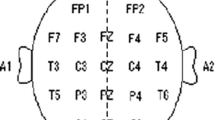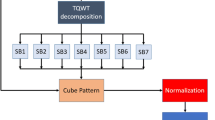Abstract
Extreme learning machine (ELM) is an effective machine learning technique with simple theory and fast implementation, which has gained increasing interest from various research fields recently. A new method that combines ELM with probabilistic model method is proposed in this paper to classify the electroencephalography (EEG) signals in synchronous brain–computer interface (BCI) system. In the proposed method, the softmax function is used to convert the ELM output to classification probability. The Chernoff error bound, deduced from the Bayesian probabilistic model in the training process, is adopted as the weight to take the discriminant process. Since the proposed method makes use of the knowledge from all preceding training datasets, its discriminating performance improves accumulatively. In the test experiments based on the datasets from BCI competitions, the proposed method is compared with other classification methods, including the linear discriminant analysis, support vector machine, ELM and weighted probabilistic model methods. For comparison, the mutual information, classification accuracy and information transfer rate are considered as the evaluation indicators for these classifiers. The results demonstrate that our method shows competitive performance against other methods.








Similar content being viewed by others
References
Ahmed N, Campbell M (2011) Variational bayesian learning of probabilistic discriminative models with latent softmax variables. IEEE Trans Signal Process 59:3143–3154. doi:10.1109/TSP.2011.2144587
Bhattacharyya S, Konar A, Tibarewala DN (2014) Motor imagery, P300 and error-related EEG-based robot arm movement control for rehabilitation purpose. Med Biol Eng Comput 52:1007–1017. doi:10.1007/s11517-014-1204-4
Carlson T, Del R, Millan J (2013) Brain-controlled wheelchairs: a robotic architecture. IEEE Robot Autom Mag 20:65–73. doi:10.1109/MRA.2012.2229936
Chang C-C, Lin C-J (2011) LIBSVM: a library for support vector machines. ACM Trans Intell Syst Technol (TIST) 2:27
Corralejo R, Nicolas-Alonso LF, Alvarez D, Hornero R (2014) A P300-based brain-computer interface aimed at operating electronic devices at home for severely disabled people. Med Biol Eng Comput 52:861–872. doi:10.1007/s11517-014-1191-5
Coyle D, McGinnity TM, Prasad G (2010) Improving the separability of multiple EEG features for a BCI by neural-time-series-prediction-preprocessing. Biomed Signal Process Control 5:196–204. doi:10.1016/j.bspc.2010.03.004
Dahne S, Biessmann F, Meinecke FC et al (2013) Integration of multivariate data streams with bandpower signals. IEEE Trans Multimedia 15:1001–1013. doi:10.1109/TMM.2013.2250267
del Millan JR, Mourino J (2003) Asynchronous BCI and local neural classifiers: an overview of the adaptive brain interface project. IEEE Trans Neural Syst Rehabil Eng 11:159–161. doi:10.1109/TNSRE.2003.814435
Duda RO (2001) Pattern classification, 2nd edn. Wiley-Interscience, New York
Fabiani GE, McFarland DJ, Wolpaw JR, Pfurtscheller G (2004) Conversion of EEG activity into cursor movement by a brain-computer interface (BCI). IEEE Trans Neural Syst Rehabil Eng 12:331–338. doi:10.1109/TNSRE.2004.834627
Han Y, He B (2014) Brain-computer interfaces using sensorimotor rhythms: current state and future perspectives. IEEE Trans Biomed Eng 61:1425–1435. doi:10.1109/TBME.2014.2312397
Hawkins GE, Mittner M, Boekel W et al (2015) Toward a model-based cognitive neuroscience of mind wandering. Neuroscience 310:290–305. doi:10.1016/j.neuroscience.2015.09.053
Hazrati MK, Erfanian A (2010) An online EEG-based brain-computer interface for controlling hand grasp using an adaptive probabilistic neural network. Med Eng Phys 32:730–739. doi:10.1016/j.medengphy.2010.04.016
Horki P, Solis-Escalante T, Neuper C, Muller-Putz G (2011) Combined motor imagery and SSVEP based BCI control of a 2 DoF artificial upper limb. Med Biol Eng Comput 49:567–577. doi:10.1007/s11517-011-0750-2
Huang G-B, Zhou H, Ding X, Zhang R (2012) Extreme learning machine for regression and multiclass classification. IEEE Trans Syst Man Cybern Part B Cybern 42:513–529. doi:10.1109/TSMCB.2011.2168604
Huang G-B, Zhu Q-Y, Mao KZ et al (2006) Can threshold networks be trained directly? IEEE Trans Circuits Syst II Express Briefs 53:187–191. doi:10.1109/TCSII.2005.857540
Kayikcioglu T, Aydemir O (2010) A polynomial fitting and k-NN based approach for improving classification of motor imagery BCI data. Pattern Recogn Lett 31:1207–1215. doi:10.1016/j.patrec.2010.04.009
Leeb R, Lee F, Keinrath C et al (2007) Brain-computer communication: motivation, aim, and impact of exploring a virtual apartment. IEEE Trans Neural Syst Rehabil Eng 15:473–482. doi:10.1109/TNSRE.2007.906956
Lei X, Yang P, Yao D (2009) An empirical bayesian framework for brain-computer interfaces. IEEE Trans Neural Syst Rehabil Eng 17:521–529. doi:10.1109/TNSRE.2009.2027705
Lemm S, Schafer C, Curio G (2004) BCI competition 2003-data set III: probabilistic modeling of sensorimotor mu; rhythms for classification of imaginary hand movements. IEEE Trans Biomed Eng 51:1077–1080. doi:10.1109/TBME.2004.827076
Liu X, Gao C, Li P (2012) A comparative analysis of support vector machines and extreme learning machines. Neural Netw 33:58–66. doi:10.1016/j.neunet.2012.04.002
Nicolas-Alonso LF, Gomez-Gil J (2012) Brain computer interfaces, a review. Sensors 12:1211–1279. doi:10.3390/s120201211
Park S-A, Hwang H-J, Lim J-H et al (2013) Evaluation of feature extraction methods for EEG-based brain-computer interfaces in terms of robustness to slight changes in electrode locations. Med Biol Eng Comput 51:571–579. doi:10.1007/s11517-012-1026-1
Pfurtscheller G, Lopes da Silva FH (1999) Event-related EEG/MEG synchronization and desynchronization: basic principles. Clin Neurophysiol 110:1842–1857. doi:10.1016/S1388-2457(99)00141-8
Rakotomamonjy A, Guigue V (2008) BCI competition III: dataset II-ensemble of SVMs for BCI P300 speller. IEEE Trans Biomed Eng 55:1147–1154. doi:10.1109/TBME.2008.915728
Ratcliff R, McKoon G (2007) The diffusion decision model: theory and data for two-choice decision tasks. Neural Comput 20:873–922. doi:10.1162/neco.2008.12-06-420
Rieke F, Warland D, Steveninck RDRV, Bialek W (1999) Spikes: exploring the neural code, New edn. MIT Press, Cambridge
Rivet B, Cecotti H, Perrin M et al (2011) Adaptive training session for a P300 speller brain-computer interface. J Physiol Paris 105:123–129. doi:10.1016/j.jphysparis.2011.07.013
Scherer R, Muller GR, Neuper C et al (2004) An asynchronously controlled EEG-based virtual keyboard: improvement of the spelling rate. IEEE Trans Biomed Eng 51:979–984. doi:10.1109/TBME.2004.827062
Schlogl A, Brunner C (2008) BioSig: a free and open source software library for BCI research. Computer 41:44–50. doi:10.1109/MC.2008.407
Schlogl A, Lee F, Bischof H, Pfurtscheller G (2005) Characterization of four-class motor imagery EEG data for the BCI-competition 2005. J Neural Eng 2:L14–L22. doi:10.1088/1741-2560/2/4/L02
Schlogl A, Keinrath C, Scherer R, Furtscheller P (2003) Information transfer of an EEG-based brain computer interface. In: Proceedings of first international IEEE EMBS conference on neural engineering, 2003. pp. 641–644
Vidaurre C, Kramer N, Blankertz B, Schlgl A (2009) Time domain parameters as a feature for EEG-based Brain–Computer interfaces. Neural Netw 22:1313–1319. doi:10.1016/j.neunet.2009.07.020
Vidaurre C, Pascual J, Ramos-Murguialday A et al (2013) Neuromuscular electrical stimulation induced brain patterns to decode motor imagery. Clin Neurophysiol 124:1824–1834. doi:10.1016/j.clinph.2013.03.009
Yuan Q, Zhou W, Li S, Cai D (2011) Epileptic EEG classification based on extreme learning machine and nonlinear features. Epilepsy Res 96:29–38. doi:10.1016/j.eplepsyres.2011.04.013
Acknowledgments
This work was supported in part by the National Natural Science Foundation of China under Grant 61175064, 61273314 and 61403427, in part by Postdoctoral Research Plan Foundation of Hunan Province under Grant 2014RS4029, in part by Postdoctoral Foundation of Central South University under Grant 126649, in part by the Innovation-driven Plan in Central South University under Grant 2015CXS012 and Grant 2015CX007, and in part by the Program for New Century Excellent Talents in University under Grant NCET-13-0596.
Author information
Authors and Affiliations
Corresponding author
Rights and permissions
About this article
Cite this article
Tan, P., Tan, Gz., Cai, Zx. et al. Using ELM-based weighted probabilistic model in the classification of synchronous EEG BCI. Med Biol Eng Comput 55, 33–43 (2017). https://doi.org/10.1007/s11517-016-1493-x
Received:
Accepted:
Published:
Issue Date:
DOI: https://doi.org/10.1007/s11517-016-1493-x




